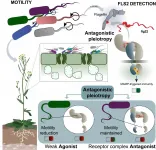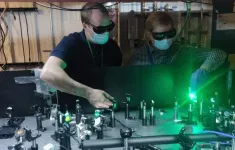(Press-News.org) BIRMINGHAM, Ala. - Researchers have found an unexpected synergy between a T-cell stimulatory protein -- the ICOS ligand -- and interleukin-10, an immunoregulatory cytokine, to prevent inflammatory bowel disease in mice. The study will aid the understanding of, and future research into, this immune disorder, which includes Crohn's disease and ulcerative colitis. About 1.6 million Americans have inflammatory bowel disease.
Interleukin-10, or IL-10, was already known as a major player to prevent gut inflammation by establishing and maintaining immune homeostasis in the gut, where it is vital for the host to have a peaceful coexistence with normal intestinal microbes, while the immune system still stands guard against pathogens. IL-10 is produced by CD4+ T-regulatory cells in the gut.
ICOS ligand, or ICOSL, is expressed on B cells and dendritic cells of the immune system, and it helps to control T-cell activation and differentiation, two steps of the host immune response to microbes and microbial pathogens. Both IL-10 and ICOSL were known risk alleles for inflammatory bowel disease, but their synergistic interaction was not known.
The research, published in the Proceedings of the National Academy of Sciences, was led by Craig Maynard, Ph.D., assistant professor in the University of Alabama at Birmingham Department of Pathology.
"Collectively, our data identify a synergy between two inflammatory bowel disease-related pathways -- T-cell-derived IL-10 and ICOSL-dependent anti-commensal antibodies -- that promotes mutualism with the gut microbiota," Maynard said. "Furthermore, we identify ICOSL deficiency as an effective platform for exploring the functions of anti-commensal antibodies in host-microbiota mutualism."
In humans, complete deficiency of ICOSL or the ICOS receptor that ICOSL bind to causes a combined immunodeficiency with repeated bacterial and viral infections. In contrast, mice with ICOSL or ICOS receptor deficiencies maintain a healthy gut homeostasis under specific pathogen-free conditions.
In the current study, the UAB researchers found that ICOSL-deficient mice -- like the ICOS receptor-deficient mice Maynard's group has previously studied -- harbored increased frequencies and numbers of IL-10-producing CD4+ T cells, particularly in the proximal colon.
When researchers transiently depleted the IL-10-producing cells in the ICOSL-deficient mice, they saw a striking change -- rapid onset of severe inflammation in the proximal colon.
While the number of IL-10-producing CD4+ T cells was increased in the ICOSL-deficient mice, the numbers of colon-associated T-follicular helper cells and the plasma cells that produce immunoglobulin A and immunoglobulin G, or IgA and IgG respectively, were decreased.
The mice also had dramatic reductions in antibodies against normal gut microbes, which included a limited recognition of antigens implicated in the progression of inflammatory bowel disease. These included flagellin antigens derived from several members of the family Lachnospiraceae. These bacteria are known to enrich in the mucus-associated communities of the gut, and Crohn's disease patients have antibodies against two of the Lachnospiraceae flagellin antigens. The mice also had reduced IgA and IgG antibodies that targeted antigens from multiple species of anaerobic bacteria known to be associated with active inflammatory bowel disease.
Simultaneous ablation of both pathways, ICOSL and IL-10, in newborn mice caused severe colitis with evidence of disease as early as four weeks, if the mice were fostered with ICOSL-deficient dams. However, this early onset intestinal inflammation was delayed when the newborn mice were fostered by ICOSL-sufficient dams, showing a protective role for maternal antibodies.
Maynard says the overall results suggest that induction of ICOSL-dependent antibodies and T-cell-derived IL-10 may be simultaneous host adaptations to microbial occupation of a niche near the epithelium in the gut. "Future exploration of the specific microbes that drive these responses," he said, "could potentially identify novel antigen-specific approaches to bolster mucosal immune defenses."
INFORMATION:
Co-authors with Maynard on the study, "ICOS ligand and IL-10 synergize to promote host-microbiota mutualism," are Ashley E. Landuyt, Barbara J. Klocke, Rachel Q. Muir, Melissa S. Jennings and Goo Lee, UAB Department of Pathology; Lennard W. Duck and Charles O. Elson, Division of Gastroenterology and Hepatology, UAB Department of Medicine; Keri M. Kemp, Division of Nephrology, UAB Department of Medicine; Samuel I. Blum and Hubert M. Tse, UAB Department of Microbiology; and Casey D. Morrow, UAB Department of Cell, Developmental and Integrative Biology.
Support came from National Institutes of Health grants DK118386, AI007051 and GM088010; Crohn's and Colitis Foundation Research Initiatives Award 558420; and the University of Alabama at Birmingham Microbiome Center.
Efforts to shift from petrochemical plastics to renewable and biodegradable plastics have proven tricky -- the production process can require toxic chemicals and is expensive, and the mechanical strength and water stability is often insufficient. But researchers have made a breakthrough, using wood byproducts, that shows promise for producing more durable and sustainable bioplastics.
A study published in Nature Sustainability, co-authored by Yuan Yao, assistant professor of industrial ecology and sustainable systems at Yale School of the Environment (YSE), outlines the process of deconstructing the porous matrix of natural wood into a slurry. The researchers say the resulting material shows ...
Researchers from the Center for Health, Work & Environment (CHWE) at the Colorado School of Public Health have published a paper in the International Journal of Environmental Research and Public Health studying the effectiveness of applying Total Worker Health (TWH) in an international context. The study, led by a team at CHWE, is the first to examine how a TWH framework operates outside of a western context in Latin America workforces.
"Although recent reviews show that TWH intervention studies have had some global reach, the vast majority have been conducted in Western countries," says lead researcher Diana Jaramillo. "While global organizations, as well as governmental entities in Latin America, acknowledge the importance ...
Researchers at GMI - Gregor Mendel Institute of Molecular Plant Biology of the Austrian Academy of Sciences, the University of North Carolina at Chapel Hill and The Howard Hughes Medical Institute (HHMI) use two complementary approaches to unveil a co-evolutionary mechanism between bacteria and plants and also explain complex immune response patterns observed in the wild. Together the papers change the way scientists have been thinking about the relationship of a bacterial antigenic component with its plant immune receptor. The two papers are published back to back in the journal Cell Host & Microbe.
Immune responses have developed in virtually all organisms over evolutionary time scales to protect them from foreign ...
LOS ALAMOS, N.M., March 25, 2021--A new class of quantum dots deliver a stable stream of single, spectrally tunable infrared photons under ambient conditions and at room temperature, unlike other single photon emitters. This breakthrough opens a range of practical applications, including quantum communication, quantum metrology, medical imaging and diagnostics, and clandestine labeling.
"The demonstration of high single-photon purity in the infrared has immediate utility in areas such as quantum key distribution for secure communication," said Victor Klimov, lead author of a paper published ...
Opioids are the main driver of fatal drug overdoses in the United States, according to the Centers for Disease Control and Prevention, resulting in 46,802 deaths in 2018, usually because the person stops breathing.
Naloxone -- a Food and Drug Administration-approved medication used to reverse overdoses from opioids, such as heroin, morphine and oxycodone -- works by restoring normal respiration to a person whose breathing has slowed or stopped.
"Opioid overdoses cause the largest number of accidental and avoidable deaths," said Peter Davidson, PhD, associate professor in the Department of Medicine at University of California San Diego School of Medicine. "The human toll of drug addiction is devastating. Using naloxone to prevent opiate overdoses can and has saved many lives."
In ...
A major goal of organic and medicinal chemistry in recent decades has been the rapid synthesis of three-dimensional molecules for the development of new drugs. These drug candidates exhibit a variety of improved properties compared to predominantly flat molecular structures, which are reflected in clinical trials by higher efficacy and success rates. However, they could only be produced at great expense or not at all using previous methods. Chemists led by Prof. Frank Glorius (University of Münster, Germany) and his colleagues Prof. M. Kevin Brown (Indiana University Bloomington) and Prof. Kendall N. Houk (University of California, Los Angeles) have now succeeded in converting several classes of flat ...
Skoltech scientists and their colleagues have proposed a new human height inheritance model that accounts for the interaction between various factors that influence adult human height. The research was published in the European Journal of Human Genetics.
Human height is a classical quantitative trait that depends on sex, genetics, and the environment.
Scientists from Skoltech, Novosibirsk State University, the Institute of Cytology and Genetics of the Siberian Branch of RAS, and the Institute of Science and Technology in Vienna analyzed the human height distribution ...
Buried beneath 20 kilometers of ice, the subsurface ocean of Enceladus--one of Saturn's moons--appears to be churning with currents akin to those on Earth.
The theory, derived from the shape of Enceladus's ice shell, challenges the current thinking that the moon's global ocean is homogenous, apart from some vertical mixing driven by the warmth of the moon's core.
Enceladus, a tiny frozen ball about 500 kilometers in diameter (about 1/7th the diameter of Earth's moon), is the sixth largest moon of Saturn. Despite its small size, Enceladus attracted the ...
About two decades after first devising a new kind of vaccine, Oregon Health & Science University researchers are unlocking why it stops and ultimately clears the monkey form of HIV, called SIV, in about half of nonhuman primates - and why it's a promising candidate to stop HIV in people.
In scientific papers that were simultaneously published today in the journals Science and Science Immunology, creators of the cytomegalovirus, or CMV, vaccine platform describe the unusual biological mechanisms through which it works.
The findings also helped fine-tune VIR-1111, the CMV-based experimental vaccine against HIV that was developed at OHSU and is now being evaluated in a Phase 1 clinical trial. The trial is being conducted by Vir Biotechnology, which ...
SILVER SPRING, Md. - As concern has grown over COVID-19 variants and their implications for how well COVID-19 vaccines will protect against the virus, researchers have proposed a method to examine instances of SARS-COV-2 infections in people who have received a COVID-19 vaccine.
Genomic sieve analysis of these so-called "breakthrough" SARS-CoV-2 infections in COVID vaccine trials is a critical tool to identify viral mutations associated with vaccine failure and to predict how vaccination impacts the virus' evolution.
Dr. Morgane Rolland, Chief of Viral Genetics ...




